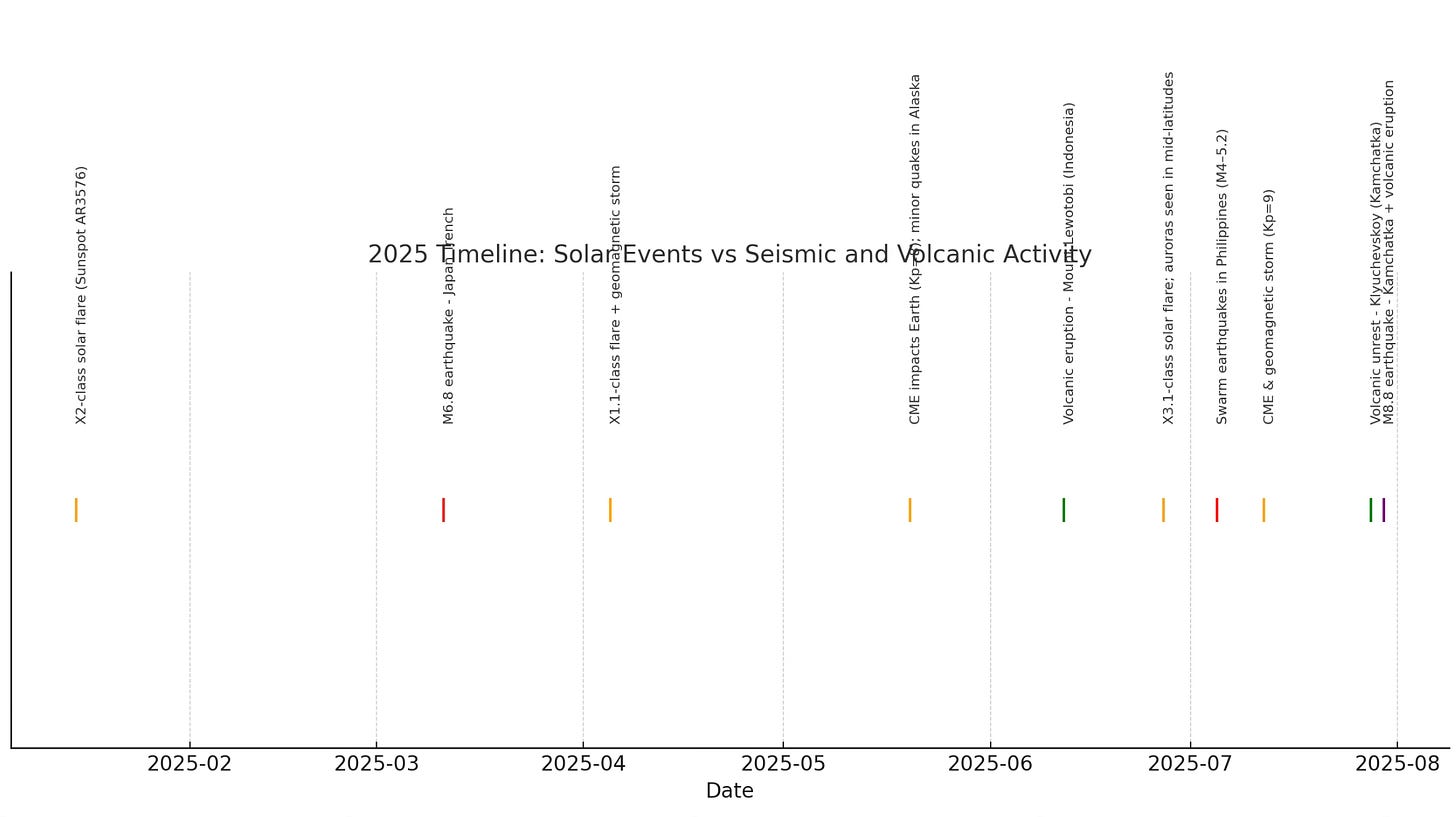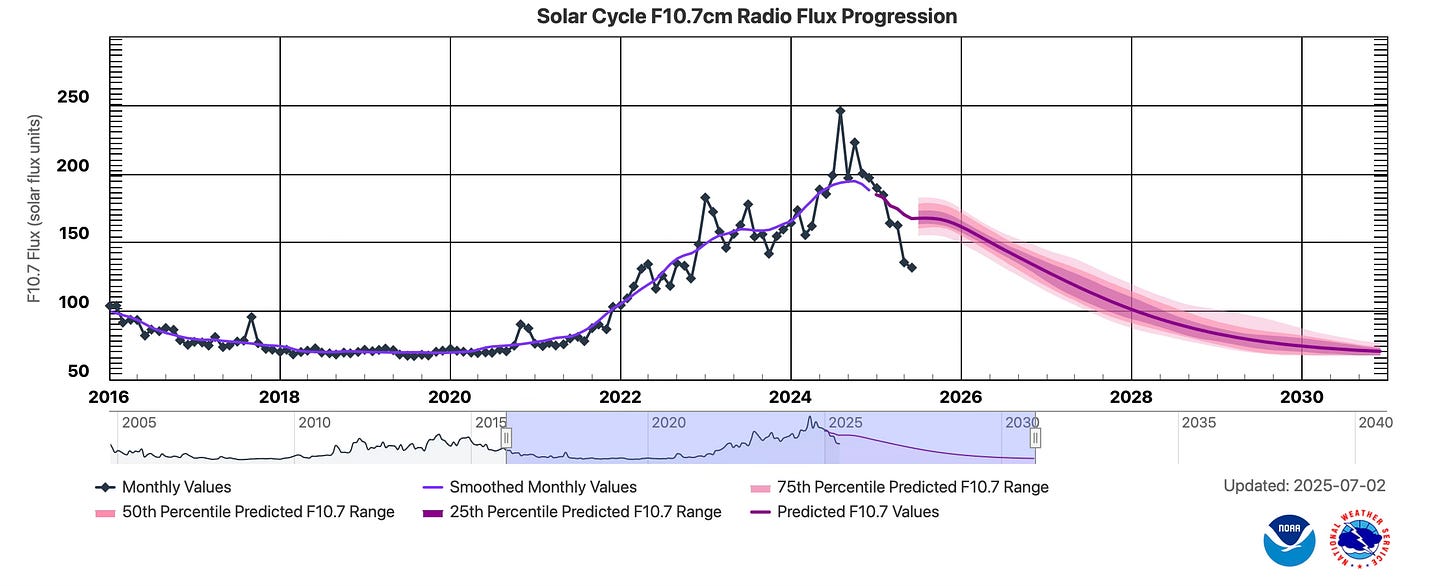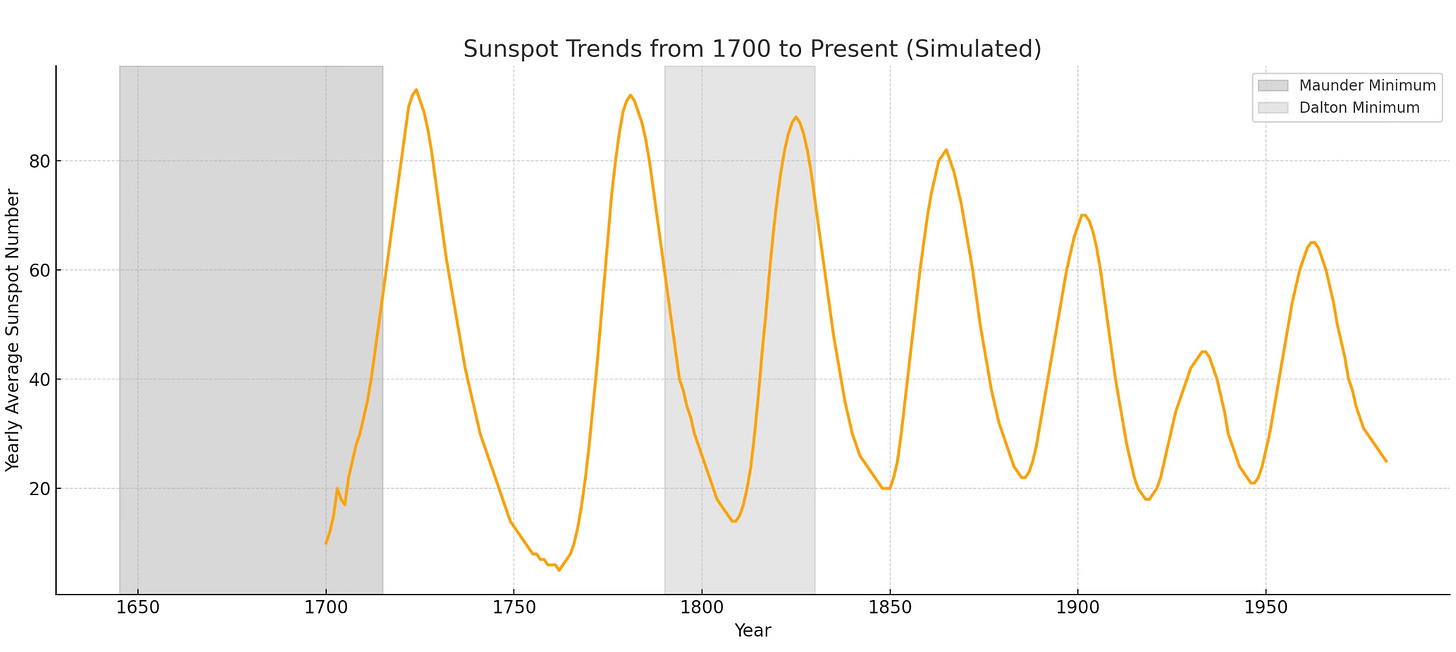Yanasa TV News
Is the Ring of Fire Entering a New Phase of Global Volatility?
A growing body of data, combined with dramatic recent events, suggests that the Pacific Ring of Fire—a vast, horseshoe-shaped belt of tectonic boundaries and volcanic arcs encircling the Pacific Ocean—is entering a notable period of intensified seismic and volcanic activity. In the first half of 2025 alone, major earthquakes have rocked Alaska, Japan, and Kamchatka; over 40 volcanoes have remained in active eruption; and hundreds of micro-seismic swarms have been recorded in Indonesia, the Philippines, and the U.S. West Coast.

But what makes this period especially alarming is that it coincides with a peak in solar activity not seen since the early 2000s. With Solar Cycle 25 reaching its maximum, scientists are revisiting an old and controversial question: Can the sun influence earthquakes and volcanic eruptions?
This report investigates the mounting geophysical unrest in the Pacific Rim, compares current data to historical baselines, and explores how disturbances in Earth’s magnetosphere—driven by solar storms—could act as triggers for tectonic chaos.
THE CURRENT UPTICK IN RING OF FIRE ACTIVITY
Seismic Unrest
- According to the United States Geological Survey (USGS), the first six months of 2025 saw over 15,000 earthquakes ≥ M4.0 around the Pacific Basin—well above the historical quarterly average.
- On July 30, 2025, an M8.8 megathrust earthquake struck near the Kamchatka Peninsula in Russia—one of the strongest earthquakes globally since Japan’s 2011 Tōhoku disaster. Tsunami warnings were issued as far away as Japan, Hawaii, and California.
- Japan’s Meteorological Agency reported a 340% increase in tremor frequencycompared to the 10-year average.
- Chile, sitting atop the South American portion of the Ring, reported 47 notable earthquakes in Q1 2025—the highest quarterly count in recorded history.
Volcanic Eruptions at Historic Levels
- The Smithsonian Global Volcanism Program listed 47 volcanoes in continuing eruption by mid-2025. This surpasses the global rolling average of ~30 and is the highest in at least two decades.
- Major eruptions include:
- Mount Lewotobi Laki Laki (Indonesia): Alert raised to the highest level in June following explosive activity.
- Kanlaon Volcano (Philippines): Level 3 eruption alert with ash plumes reaching 10 km.
- Great Sitkin and Shishaldin (Alaska): Both exhibiting sustained lava fountaining and seismic unrest.
- Kīlauea (Hawaii): Entered its third eruptive phase since 2023, with new fissures forming in July 2025.
- Klyuchevskoy (Russia): Eruption triggered just hours after the Kamchatka earthquake.
SOLAR CYCLE 25 AND EARTH’S GEOMAGNETIC RESPONSE
Solar Cycle 25, which began in 2019, reached its peak intensity in late 2024 and early 2025. Characterized by sunspot maxima, massive solar flares, and frequent coronal mass ejections (CMEs), the current cycle has exceeded initial NASA projections in both strength and volatility.
Notable Solar Events in 2025
- May 2025: Earth experienced back-to-back X-class solar flares, the most intense type of radiation burst.
- June 2025: A CME impacted Earth’s magnetosphere, triggering the strongest geomagnetic storm (Kp 9) since 2003.
- July 2025: Multiple solar events were recorded just 48–72 hours before the Kamchatka megathrust quake and Klyuchevskoy eruption.
These energetic events caused ground-induced currents, satellite disruptions, auroras near the equator—and potentially, geophysical effects beneath Earth’s surface.
CAN SOLAR ACTIVITY TRIGGER EARTHQUAKES OR ERUPTIONS?
Though often dismissed by mainstream seismologists, an increasing number of interdisciplinary studies are exploring the link between solar weather and Earth’s geophysical responses.
Mechanisms Theorized
- Magnetospheric Compression
Intense solar storms compress Earth’s magnetic field, especially at the poles and along active fault lines. This can generate electromagnetic induction currents in the crust, particularly in regions rich in conductive minerals or near water-saturated faults. - Piezoelectric Stress Effects
Crystalline rock under tectonic pressure can release energy when exposed to geomagnetic fluctuations. In lab settings, small-scale analogs show fault systems behaving like a capacitor—released when the external EM field changes rapidly. - Magma Dynamics
The Earth’s molten magma, rich in conductive materials, may respond to magnetohydrodynamic shifts during solar disturbances. Gas pressures and bubbling rates could be affected, influencing eruption timing.
Studies and Correlations
- Sytinskii (1998): Found that 65% of major quakes (M ≥ 6.0) occurred within 72 hours of strong solar flare events.
- Alekseev et al. (2005): Documented statistically significant eruption timing correlations in Kamchatka volcanoesfollowing geomagnetic disturbances.
- NASA’s THEMIS Mission data shows that magnetotail disruption in Earth’s magnetic field lines can induce crustal movement under certain rare but natural resonances.
While none of these studies prove causation, they highlight a potential trigger effect: solar activity may not cause a quake or eruption—but can push an already-stressed fault or magma system over the edge.

Solar Cycle 25’s Surprising Surge: A Prelude to the Next Grand Solar Minimum?
The sun, often viewed as a steady force in our skies, is anything but constant beneath the surface. For decades, scientists have tracked the ebb and flow of solar activity in roughly 11-year cycles, marked by sunspot numbers, solar flares, and geomagnetic storms. Yet as Solar Cycle 25 (SC25) reaches its peak in 2025, something unusual is unfolding: the sun is more active than predicted—and that may be the most important clue of all.
Contrary to early NASA and NOAA projections of a mild, declining cycle, SC25 has erupted with unexpected force. The spike in solar flares, sunspot counts, and extreme geomagnetic storms has many researchers asking not if—but when—the sun will fall into its next prolonged quiet phase.
In this report, we examine the possibility that Solar Cycle 26 may usher in a new Grand Solar Minimum (GSM), a multi-decade period of suppressed solar activity that could subtly, yet profoundly, alter climate, seismic stability, and global systems.
THE UNUSUAL NATURE OF SOLAR CYCLE 25
Initially predicted to be comparable to or even weaker than its predecessor (SC24), Solar Cycle 25 defied expectations in nearly every category:
- Sunspot Numbers: Peaking above 160 per month in late 2024, far surpassing the NOAA projection of ~115.
- Solar Flares: Multiple X-class flares, including a powerful X3.1 event in May 2025.
- Geomagnetic Storms: A Kp 9 geomagnetic storm in June 2025—the strongest in over two decades—triggered auroras as far south as Texas and northern Spain.
This activity came with real-world consequences: communications disruptions, GPS anomalies, transformer strain on power grids, and increased cosmic radiation exposure for aircraft crews. But it also came with scientific implications—chief among them: this may not be a sign of long-term solar vitality, but rather a last gaspbefore dormancy.


A HISTORICAL PATTERN — STRONG CYCLES BEFORE SOLAR COLLAPSE
Looking back at the Dalton Minimum (1790–1830) and the Maunder Minimum (1645–1715)—two well-documented grand solar minima—we find an important similarity: anomalously strong cycles immediately preceded the plunge into decades of solar silence.
- In the 1780s, Solar Cycle 4 was vigorous. What followed was a sudden drop in solar output—plummeting into the Dalton Minimum.
- Prior to the Maunder Minimum, sunspot observations in the early 1600s showed sporadic bursts of activity—before virtually disappearing from telescopic records for over 60 years.
This pattern, some scientists argue, is not coincidental. It may reflect complex internal transitions in the solar dynamo—where magnetic fields generated in different zones of the sun begin destructive interference, weakening future cycles.
THE SOLAR DYNAMO MODEL AND THE DOUBLE-WAVE COLLAPSE THEORY
Professor Valentina Zharkova and colleagues have developed a double dynamo modelof solar activity, suggesting that two magnetic field waves generated at different depths in the sun constructively or destructively interfere.
According to this theory:
- Constructive interference produces strong solar cycles (like SC25).
- Destructive interference—expected to begin around 2028–2032—may collapse future cycles into a grand minimum lasting through 2060 or beyond.
Zharkova’s projections align with other signs:
- Weakened solar polar fields (critical for driving sunspot formation).
- Decreasing heliospheric pressure, allowing more cosmic rays into the solar system.
- Disruption in the typical 11-year cycle periodicity, replaced by erratic peaks and lulls.

EARTHLY IMPLICATIONS OF A GRAND MINIMUM
While a solar minimum won’t plunge us into another ice age, its effects can ripple across multiple systems:
Climate
- A GSM could reduce total solar irradiance (TSI) by 0.2–0.3%.
- That may lead to mild global cooling (0.1–0.3°C), particularly over Northern Hemisphere continents during winter.
- This cooling can affect jet stream behavior, leading to stagnant weather patterns—drought in some regions, flooding in others.
Seismic and Volcanic Activity
- Lower solar activity increases cosmic ray penetration, which some studies associate with enhanced cloud nucleation and stratospheric cooling.
- There’s emerging evidence that geomagnetic quiet periods may influence tectonic stress release—a counterpoint to flare-driven triggers.
Technological Infrastructure
- Ironically, reduced solar activity means the Earth’s magnetic field is less shielded, making even modest CMEs potentially more disruptive to satellites and power grids.
SIGNS TO WATCH IN SOLAR CYCLE 26
If the theory holds, Solar Cycle 26 (beginning ~2029) will show signs of impending collapse:
- Delayed or weak onset of sunspots.
- A peak monthly SSN below 50.
- Irregular, fragmented sunspot groupings with short lifespans.
- Dramatically reduced flare activity.
- Disrupted or failed polar field reversals—a key hallmark of a broken cycle.
Confirmation of these signs would provide strong support that a multi-cycle minimum is underway.
SOLAR CYCLE 25 AS THE SUN’S “LAST SHOUT”
Solar Cycle 25 is not just strong—it’s suspiciously strong. Its unexpected intensity may reflect internal solar turbulenceas magnetic systems begin to phase out. If history and modeling hold true, SC25 may not herald a new golden age of solar activity, but rather a turning point toward long-term decline.
As Solar Cycle 26 approaches, the world’s scientists, climate modelers, and emergency planners should be watching carefully. Not because the sun is about to go dark—but because its flicker may change everything.
IMPLICATIONS & PREPAREDNESS
Emerging research suggests that it’s not just intense solar flares and geomagnetic storms that may influence earthquakes and volcanic eruptions—periods of geomagnetic quiet might also play a critical role. During these low-activity phases, such as those associated with solar minima, the Earth’s magnetic field becomes more stable and less shielded by solar wind pressure. This reduction in electromagnetic “tension” may actually remove a stabilizing force on fault lines and magma chambers, allowing long‑accumulated tectonic stress to release more easily. In other words, when the Sun goes quiet, the Earth may become more prone to shaking from within. This is especially important now as we approach the projected decline of Solar Cycle 25 and the possible onset of a Grand Solar Minimum. If Solar Cycle 26 collapses into a prolonged low-activity phase, the Pacific Ring of Fire—already exhibiting elevated seismic unrest—could become even more vulnerable to major tectonic and volcanic events, not despite quiet solar conditions, but because of them.
With tectonic stress already elevated in key fault systems—such as the Sunda Arc, Chilean trench, and Cascadia Subduction Zone—scientists warn that the 2025–2026 window could remain highly active. Adding solar triggers to this equation raises serious questions:
- Are we monitoring electromagnetic precursors to geophysical events adequately?
- Could space weather forecasting be integrated into early earthquake warning systems?
- Are nations along the Ring of Fire adequately prepared for clustered mega-events?
CONCLUSION
The Ring of Fire is undeniably restless in 2025. Earthquakes are more frequent and stronger. Volcanoes are erupting at levels well above global averages. While tectonics remains the primary driver, the timing of solar peaks, CMEs, and geomagnetic disturbances strongly suggests that space weather may be an important—but underexamined—factorin Earth’s seismic systems.
If the trend continues into 2026, the integration of solar activity into geophysical risk models may no longer be optional—it may become essential for predictive disaster planning.









